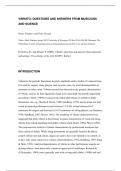VIBRATO: QUESTIONS AND ANSWERS FROM MUSICIANS
AND SCIENCE
Renee Timmers and Peter Desain
'Music, Mind, Machine' group, NICI, University of Nijmegen, PO Box 9104, 6500 HE Nijmegen, The
Netherlands; E-mail: timmers@nici.kun.nl or desain@nici.kun.nl; Info: www.nici.kun.nl/mmm/
[Timmers, R., and Desain, P. (2000). Vibrato: questions and answers from musicians
and science. Proceedings of the sixth ICMPC. Keele.]
INTRODUCTION
Vibrato is the periodic fluctuation in pitch, amplitude and/or timbre of a musical tone.
It is used by singers, string players, and, in some cases, by wind instrumentalists to
ornament or color a tone. Vibrato research has focused on the general characteristics
of vibrato, such as its form (generally found to be sinusoidal, but mostly trapezoidal
according to Horii, 1989b), its perceived central pitch (mean or median of pitch
fluctuation, see, e.g., Shonle & Horan, 1980, Sundberg, 1978), and its mean rate and
extent in musical performances (rate between 5.5-8 Hz, extent between 0.6-2
semitones for singers and between 0.2-0.35 semitones for string players, see Seashore,
1938; Sundberg, 1987; Meyer, 1992). The modeling of vibrato characteristics has
suggested that pitch vibrato is the primary acoustic characteristic of vocal and string
vibrato from which amplitude and timbre vibrato result (Horii, 1989a; Meyer 1992).
The (un)conscious control of vibrato characteristics by professional musicians has
been a point of debate. While string instruments are generally found to be able to
control vibrato rate and extent, singers are said to have very limited to no control, or
to have only some control over vibrato extent (Seashore, 1932; Sundberg, 1987; King
& Horii, 1993). Analyzed dependencies of vibrato to other performance aspects are
(among others): short notes only contain an upper arch (Castellengo, Richards &
d’Alessandro, 1989); notes generally start with a rising pitch (Horii, 1989b) and end
, in the direction of the transition (Sundberg, 1979). Equal debate concerns the
dependency between vocal vibrato and pitch height, which is confirmed by Horii
(1989b) and rejected by Shipp, Doherty & Haglund (1990).
In this paper, we will focus on vibrato as an expressive means within musical
performances. In this respect, we assume that vibrato may be used by musicians to
stress notes or to convey a certain musical interpretation. It is an area of research that
recently gained interest and is still in an explorative stage (see the contribution of
Gleiser & Friberg to this proceedings). We turn to musicians’ hypotheses concerning
the expressive function of vibrato and compare this to observations made on the
relation between music structural characteristics and vibrato rate and extent in actual
performances. The analyses of the performance data are based on the predictions of
expressive vibrato behavior (Sundberg, Friberg & Frydén, 1991) and on predictions
stemming from piano performance research that attributes expressive behavior to the
pianist’s interpretation of musical structure (e.g., Clarke, 1988). The comparison aims
to show that the scientific inquiries could be inspired by hypotheses stemming from
musicians/experts who devote their life to refining their control of musical parameters
for expressive means, and teaching that to students. Vise versa, the scientific results
can achieve a musical meaningfulness and value, also for musicians and teachers.
METHOD
Subjects
Five professional musicians participated in the study: a cellist, an oboist, a tenor, a
thereminist, and a violinist. The musicians are all known-musicians for their
performance in orchestras, chamber ensembles and/or as soloists. Each participant
was paid for participation.




